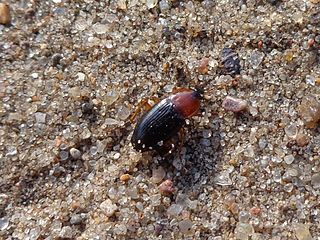
The Rocky Mountain locust is an extinct species of grasshopper that ranged through the western half of the United States and some western portions of Canada with large numbers seen until the end of the 19th century. Sightings often placed their swarms in numbers far larger than any other locust species, with one famous sighting in 1875 estimated at 198,000 square miles (510,000 km2) in size, weighing 27.5 million tons and consisting of some 12.5 trillion insects, the greatest concentration of animals ever speculatively guessed, according to Guinness World Records.
Trachelipus spretus is a species of woodlouse in the genus Trachelipus belonging to the family Trachelipodidae that can be found in Sicily.

Calathus melanocephalus is a species of blackish-red coloured ground beetle from the Platyninae subfamily that can be found everywhere in Europe except for Monaco, San Marino, Vatican City and various European, Asian and African islands. The species is mostly black coloured and have red thorax. It is found in bare, sandy soil, under stones, and in leaf litter. Its flying time is from April to September.
Calathus brevis is a species of ground beetle from the Platyninae subfamily that is endemic to Spain.
Calathus distinguendus is a species of ground beetle from the Platyninae subfamily that can be found in Bulgaria, Greece, Kosovo, Moldova, Montenegro, North Macedonia, Serbia, Voivodina, southern part of Russia and European part of Turkey. It is also found in Georgia, Asia Minor, Caucasus, and Crimea. It have 1 millimetre (0.039 in) long genitalia.

Calathus fuscipes is a species of ground beetle from the Platyninae subfamily that can be found everywhere in Europe except for Andorra, Monaco, San Marino, Vatican City and various islands.
Calathus giganteus is a species of ground beetle from the Platyninae subfamily that can be found in Albania and Greece.
Calathus hispanicus is a species of ground beetle from the Platyninae subfamily that can be found in Portugal and Spain.
Calathus jakupicensis is a species of ground beetle from the Platyninae subfamily that is endemic to North Macedonia.
Calathus korax is a species of ground beetle from the Platyninae subfamily that is endemic to Greece.
Calathus longicollis is a species of ground beetle from the Platyninae subfamily that can be found in Bulgaria, Greece, Russia, Armenia, Cyprus, Georgia, Israel, Lebanon and Turkey.
Calathus montivagus is a species of ground beetle from the Platyninae subfamily that can be found in Italy and Sicily.
Calathus pirazzolii is a species of ground beetle from the Platyninae subfamily that is endemic to Italy.
Calathus syriacus is a species of ground beetle from the Platyninae subfamily that can be found on Cyprus, in Ukraine and in southern part of Russia. It is also found in Azerbaijan, Armenia, Georgia, Greece, Iran, Israel, Lebanon, Syria and Turkey.
Calathus vivesi is a species of ground beetle from the Platyninae subfamily that is endemic to Spain.
Calathus vuillefroyi is a species of ground beetle from the Platyninae subfamily that is endemic to Spain.
Calathus carvalhoi is a species of ground beetle from the Platyninae subfamily that is endemic to the Azores.
Calathus obliteratus is a species of ground beetle from the Platyninae subfamily that is endemic to the Canary Islands.

Calathus is a proposed student-designed Ceres sample-return mission, that would consist of an orbiter and a lander with an ascent module. The orbiter would be equipped with a camera, a thermal imager, and a radar; the lander will have a sampling arm, a camera, and a gas chromatograph mass spectrometer. Mission objective is to return maximum 40 g of Ceresian soil. The mission was designed and proposed in 2018 with support of ESA.



